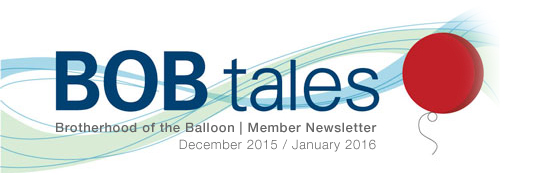
Dear Members (a note from Deb Hickey):.jpg)
Two years ago, BOB founder (and my father), Bob Marckini, was honored by the board of directors at Loma Linda University Health. They named an endowed chair after him, “The Robert J. Marckini Chair for Proton Therapy Research” for his contributions in promoting proton therapy and his support of proton therapy research. The announcement was made by BOB member Chuck Kubicki, a major supporter of proton therapy and LLU Health and a good friend of my father’s. “Having Chuck make the announcement made it even more special,” my father told me.
We have some exciting news to share with you about the Marckini Chair funding in this month’s BOB Tales. And, there’s even more good news. We were notified this month by the National Association for Proton Therapy (NAPT) that my father will be receiving a “Lifetime Achievement Award” at the annual National Proton Conference in New Orleans in January. In their communication to us, NAPT said:
Next to Dr. James M. Slater, Bob Marckini has done more to increase patient access to proton therapy than anyone else. The National Association of Proton Therapy is recognizing Bob Marckini with their Lifetime Achievement Award at the NPC2016 conference being held in January. As the founder of the Brotherhood of the Balloon, the only patient advocacy group that can claim the majority of patients treated with a particular modality as members, Bob has provided thousands of prostate cancer patients with objective information that enables them to make informed choices about their care.
As you might expect, my dad was both awestruck and humbled by this news. He also said to me, “To have my name mentioned in the same sentence with Dr. James Slater is a great honor.”
We all know he deserves this recognition. Maybe he’ll figure it out himself one of these days …
NAPT is offering a discount for any BOB member who would like to attend this specific event or the entire three-day conference. More information and details of the conference are in this month’s BOB Tales.
To say I’m proud of my father is an understatement. Working with him these past five years has changed my life. Not only do I have the opportunity to talk to my father every day and see him more often, I’m able to help him achieve his goals and be a part of his “ministry” and his passion for helping others.
When his proton treatment ended, my father set out to keep six men connected. But when more and more became interested in learning about proton therapy for prostate cancer, he began receiving emails and phone calls all hours of the day and night, seven days a week. And he answered all of them. Helping others learn about proton therapy and calming their fears became his life, and he sacrificed much to keep it going. My dad has made a huge difference in this world because of his compassion for others. I’m overjoyed that he’s being recognized for this in such meaningful ways.
In this issue of BOB Tales, we also recap our visit to Loma Linda in late October for the 25th anniversary celebration of the James M. Slater Proton Treatment & Research Center. For me, the event was an awesome experience and one I will never forget. From a lavish, all purple dinner with both Drs. Slater in attendance, to all-day events including a hike in the mountains, truly amazing hospital tours, two important seminars, a viewing of a documentary that left a room of 100 people in tears, an irreverent roast of one of our favorite people, and an afternoon celebration of the trailblazing technology that has changed all our lives, it was an extraordinary experience.
This December/January issue of BOB Tales is a big one. In fact, it’s by far our largest newsletter to date. It’s loaded with valuable information on topics that we know will be helpful to our membership.
As always, we welcome your feedback and suggestions for future newsletters. Just send an email to [email protected].
Deb Hickey
To print the BOB Tales newsletter or view the newsletter with a larger font size, click here for the PDF file.
In This Issue:
- Prostate cancer survivors—watch your dairy intake
- Study suggests spirituality helps cancer care
- “Mayo Brand Name Gives Proton Beam Program the Edge”
- Proton therapy could relieve chronic pain of U.S. military veterans
- Proton usually not mentioned as treatment alternative
- Hundreds gathered at LLUCC to celebrate 25 years of trailblazing proton technology
- Recap of ASTRO 2015 annual meeting
- National Proton Conference 2016
- PSA lessons learned
- 7 germiest spots in your home
- 2 new proton centers opened & 2 new centers announced
.jpg)
Prostate Cancer Survivors— Watch Your Dairy Intake!
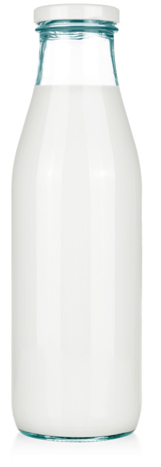 A research study published in the November 2015 International Journal of Cancer shows that prostate cancer survivors who eat dairy products may be significantly increasing their chances of cancer recurrence and mortality.
A research study published in the November 2015 International Journal of Cancer shows that prostate cancer survivors who eat dairy products may be significantly increasing their chances of cancer recurrence and mortality.
The study, titled “Dairy intake after prostate cancer diagnosis in relation to disease-specific and total mortality,” was conducted by epidemiologists at the Harvard School of Public Health and Harvard Medical School.
Researchers concluded that prostate cancer survivors who consumed three or more servings/day of dairy products had a 76 percent higher risk of total mortality and a 141 percent higher risk of prostate cancer-specific mortality compared to men who consumed less than one dairy product/day.
The study followed 926 men with non-metastatic prostate cancer who completed a diet questionnaire a median
of five years after diagnosis and were followed thereafter for a median of 10 years to assess mortality.
The association between high-fat dairy and mortality risk appeared to be stronger than that of low-fat dairy, but the difference was not statistically significant. In other words, both low-fat and high-fat dairy consumption appears to increase mortality risk for prostate cancer patients.
Study Suggests Spirituality Helps Cancer Care
According to research, a cancer patient’s spirituality and religious beliefs may benefit their mental and physical health. An article, published in the journal, Cancer, reported on a study involving more than 44,000 patients.
While researchers cannot point to a clear cause-and-effect relationship between spirituality and more preferable outcomes, their data seems to show those with stronger spirituality and religious beliefs have better outcomes.
Spirituality has undergirded the work at Loma Linda University Health, a Seventh-day Adventist organization, throughout its 110-year history. They are in the process,
in fact, of developing a “spiritual master” plan for the next several years. Those of us who were treated there—Christians, non-Christians, and even non-believers— experienced something very special during our stay.
As one of our members put it, “God is in that place.”
“Mayo Brand Name Gives Proton Beam Program the Edge”
This is the title of an article published in DotMed and other journals, which reported that Mayo Clinic’s new proton therapy program has brought significant attention and legitimacy to proton technology. As one of the top cancer centers in the country, Mayo’s adoption of proton therapy has helped shine a light on the benefits of proton therapy over conventional radiation.
Since opening in June, the Mayo Clinic Rochester Minnesota facility has treated twice as many patients as originally projected. Their focus is on pediatric patients and results thus far are quite promising. Patients are “sailing through treatments with very little side effects. So far, smooth sailing and it’s all going well,” says Dr. Robert Foote, chairman of Mayo’s radiation oncology department and director of the proton beam program.
Proton Therapy Could Relieve Chronic Pain of U.S. Military Veterans

Physician-scientists at Loma Linda University Cancer Center James M. Slater, MD Proton Treatment & Research Center are studying how proton therapy can be used to help relieve chronic pain afflicting hundreds of thousands of U.S. military service members and veterans.
“Our study is focusing on the nerve areas where the pain is coming from. We are targeting those areas with proton beam radiation to neutralize the pain so the brain doesn’t interpret it as a painful area,” said Jerry D. Slater, MD, chairman and medical director of the Loma Linda University Medical Center Department of Radiation Medicine and James M. Slater, MD, Proton Treatment & Research Center. “We hope that by neutralizing the pain, we can help decrease the need for pain medication, which not only is expensive, but can also have disabling side effects.”
Proton Usually Not Mentioned as Treatment Alternative
We recently viewed a very well done 13-minute video produced by the Hampton University Proton Therapy Institute. HUPTI has been under scrutiny by the media of late for reportedly being significantly behind its projections for patient volume since its opening in 2010.
The video outlines the reasons why proton therapy is a leading-edge treatment with significant advantages over conventional radiation for treating numerous cancers including head, neck, brain, breast, pediatric, and prostate.
In the prostate cancer segment, patients who are interviewed express their frustration over their doctors never mentioning proton therapy as a viable treatment option. “I was given just three options,” one patient said, “seeds, surgery, or standard radiation.” He told his doctor, “You’ve left one out—proton therapy.”
His doctor said, “There are not enough outcomes with proton therapy.” But the patient had done his homework, and he knew that tens of thousands of men have been treated with protons and there were plenty of studies on proton therapy. As an example, a recent prospective study conducted by the University of Florida Health Proton Therapy Institute demonstrated a 99 percent freedom from PSA progression after five years for both low-risk and intermediate-risk prostate cancers, as well as superb quality-of-life outcomes.
Hampton University radiation oncologist, Dr. Alan Thornton, stated that, “In the United States, doctors tend to try to keep their patients within the vertical tiers of hospital integration, which is a fancy way of saying the folks in one hospital system like to keep their patients all within that hospital system. I would hope that my physician would sit down with me, take off his ‘brand’ and take off his hospital association and speak to me with the honesty of a physician, because that’s what I’m coming to him for.”

BOB Comment: This is a common theme, one that we hear frequently. It’s one more reason why patients need to do their homework, do their due diligence, interview former patients, and get second and maybe third opinions before making a treatment decision. This is probably more important with a prostate cancer diagnosis than with most other diseases because of the disparate range of treatment options and the variety of potential side effects associated with each option.

Finger Length and Prostate Cancer
There are many health-related myths out there, but when something that sounds odd is backed by science and data, it becomes hard to refute. For example, new findings support finger length being linked with prostate cancer risk.
The Theory
Studies have stated that if a man’s ring finger is longer than his index finger, he has a higher chance of developing prostate cancer. These findings are not black and white, but studies show there is a link between finger length and prostate cancer risk.
The Link
A 2011 study analyzed data from 1,500 patients with prostate cancer, along with 3,000 healthy individuals as a control. The study spanned over 15 years. The findings revealed men with a longer index finger compared to their ring finger saw a reduction in their prostate cancer risk by 33 percent. Researchers claim this all has to do with HOX genes.
.gif)
We have been producing BOB Tales newsletters monthly for the past 15 years. Over the years there have been some important articles that many new members have not seen, and some older members may have forgotten. So, we decided to periodically re-run some articles from past newsletters. This one is from January 2003.
PSA Lessons Learned
Lab Error or DRE?
One of our members from Dallas, Texas, reported that his post-treatment PSA had been dropping nicely from a pre-treatment number of 46 to 0.2. Then he received an alarming surprise—a reading of 4.5! A month later he repeated the test and it was 0.1, the lowest reading yet. Interestingly, he told us his doctor did the digital rectal exam (DRE) just prior to drawing blood when the 4.5 was reported. This member’s doctor discounts the DRE as having caused the bounce, and blamed it on a probable infection or lab error.
Our uneducated, non-medical opinion is that it certainly could have been a lab error, but more likely it was the DRE just prior to the blood draw that resulted in the high reading. Bob Marckini also experienced a 60 percent PSA bounce three years after treatment when his doctor performed the DRE just before drawing blood. When Bob told him he was certain the DRE clouded the results, his doctor disagreed. Bob made a one dollar wager with him, had the test repeated, and sent him some literature reporting that anything that disturbs or stimulates the prostate prior to drawing blood may result in a PSA bump. The second test confirmed Bob’s claim. His doctor is now a believer … and a dollar poorer.
.jpg) A Frightening Spike in PSA
A Frightening Spike in PSA
Another member, from Boca Raton, Florida, watched his PSA drop steadily post-treatment to below 1. His next reading was 11.3! Worried, but suspicious it was an error, he had the test repeated. He said the result was the nicest gift he’d received in a long time—0.1.
The message here is any reading that appears to be significantly out of line (high or low) could be an error. It’s probably wise to repeat the test. Always consult your doctor on these things. And, it never hurts to get a second medical opinion.

Recap: Hundreds Gathered at LLUCC to Celebrate 25 Years of Trailblazing Proton Technology
Hundreds of BOB members, former proton patients and their family members, Loma Linda University Health (LLU Health) Staff, and others from the community gathered to celebrate Loma Linda University’s James M. Slater Proton Treatment & Research Center’s 25th Anniversary in late October.
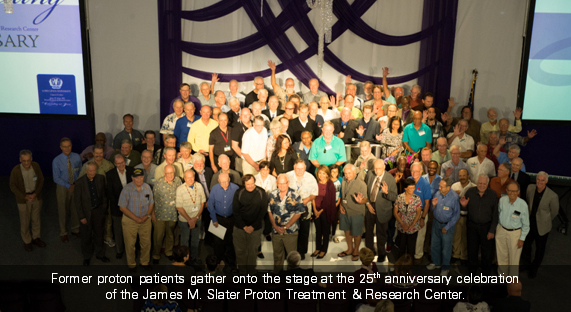
Sunday, October 26, 2015
The Edwards Mansion
Nearly 300 people attended one of two dinners to kick off the two-day celebration. One group of former patients and their families met at the Edwards Mansion in Redlands, California a 14-room Victorian relic built in 1890—for dinner and entertainment. The MC for the evening was John Lewis, PhD. Professor, Pathology and Human Anatomy School of Medicine at LLU Health. Coincidentally, Dr. Lewis is also a former proton patient.
LLU Health staff members welcomed guests before they sat down to enjoy a meal together. After dinner, “percussionist extraordinaire,” Brent Lewis, performed an amazing drum solo. Then the microphone was opened to former proton patients who wished to share their stories. Speakers included breast cancer survivor Ann Hughes, prostate cancer survivor Arnold Schuman, and 11-year-old Lailani Viveros, who was treated with proton therapy for a chordoma.
The Drayson Center
Another dinner held nearby at Loma Linda University Drayson Center was attended by 60, including Dr. James Slater, Dr. Jerry Slater, Dr. Richard Hart, and former California Congressman, Jerry Lewis. Bob Marckini, his wife, Pauline, and Deb Hickey were also in attendance for the dinner.
“I wasn’t sure what to expect … dinner at the Drayson Center?” Deb thought as she approached the building with her father and mother. “I imagined being seated underneath a basketball net.” All three were astounded when they walked in. A gym was transformed into an elegant dining room, framed in sky-high, white drapery on all sides. Four enormous crystal chandeliers hung at least thirty feet over the dining tables, which were adorned with orchid centerpieces. Soft lavendar and turquoise illuminated every corner of the room. Attendees dined while a group of talented musicians played beautiful classical music.
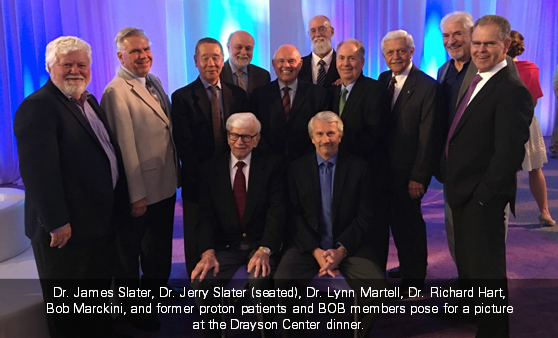
The History of Protons
A stage was set up in front of the room. The first to speak was LLU Health President Dr. Richard Hart. Dr. Hart spoke about the history of Loma Linda University’s James M. Slater Proton Treatment & Research Center and introduced a film celebrating the past 25 years of the trailblazing proton radiation technology. He then introduced several guests—the first, Dr. Jerry Slater.
The History and the Future of Proton Therapy at LLUCC
Dr. Slater noted some interesting statistics and information beginning with the fact that LLUCC has administered more than 600,000 proton treatments in the past 25 years. The focus in the early 1990s was brain and eye tumors, with an occasional prostate cancer patient. Gradually they added lung cancer, pediatric cancers, and more prostate cancer patients.
Dr. Slater continued, “Although we’ve been treating for 25 years, most of the equipment and technology has been updated and upgraded over the years. The original magnets are still there, but almost everything else is new, including control systems and software.” He then gave thanks for the generosity of those who have contributed to proton research. Because of those contributions, much progress is being made in several areas including treating breast cancer, primary liver cancer, and gastrointestinal cancers such as pancreatic cancer. Progress is also being made in development of active beam scanning (pencil beam) with installation planned for 2016. The pencil beam technology will be used primarily to treat large tumor fields.
As mentioned in our News Report section, Dr. Slater and his team are also developing methods for alleviating severe pain in military veterans returning from active duty in war zones.
Dr. Slater talked about treating some heart disease with protons, such as atrial fibrillation. By using non-invasive proton particles the risk to the patient can be significantly reduced. Targets within the heart are approximately 1 millimeter in size, making the proton particle ideal for this application.
We learned that LLUCC has also had much success in treating several non-cancerous diseases with proton, such as arteriovenous malformations (AVMs), where tangles of blood vessels in the brain bypass normal brain tissue and divert blood from the arteries to the veins.
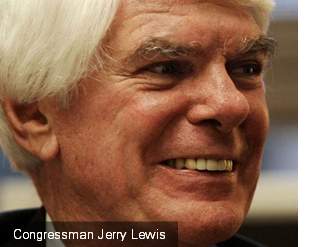 A Congressman Speaks
A Congressman Speaks
The next to approach the podium was former California Congressman, Jerry Lewis. Congressman Lewis spoke of his initial meeting with Dr. James Slater and how passionate he was about the proton project. Dr. Slater needed federal funding support or the project could not move forward. “He made an incredibly strong case,” said Mr. Lewis, which helped the congressman persuade his Appropriations Committee to support the project.
Words to Describe Dr. James Slater
Dr. Mark Reeves, Professor of Surgery and Basic Sciences, Director of LLUCC, focused on the tireless and pioneering work of Dr. James Slater describing his incredible tenacity, strength of character, and humility that served him so well during the early years of proton therapy development.
“Off the Beam? Proton Device to Fight Cancer is a Boondoggle—Or a Breakthrough?”
Next to the stage was Steve Jacobs, a long-time friend and consultant to LLU Health. He spoke of his 30-year relationship with Dr. James Slater, Dr. Jerry Slater and the Loma Linda proton community. In honoring Dr. James Slater, he commented on the March 17, 1989, issue of The Wall Street Journal. The front-page story that day announced the upcoming opening of the first hospital-based proton treatment center at LLU Health. The title of the article was, “Off the Beam? Proton Device to Fight Cancer is a Boondoggle —Or a Breakthrough?” Other places in the article referred to proton therapy as “medical technology run amok,” and questioned whether Dr. Slater was “a visionary or delusional.”
Mr. Jacobs noted there were many skeptics back then and the resistance was significant. Nevertheless, Dr. Slater and the team at LLU Health prevailed. Dr. Slater was quoted in the article predicting that someday there will be 100 proton centers treating patients. Mr. Jacobs pointed out that today, 25 years later, there are 103 proton centers either operating, under construction, or in development.
25 Years of Protons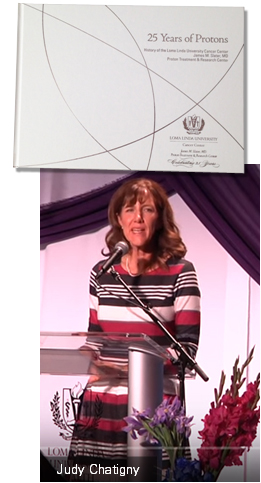
Judy Chatigny, Executive Director of LLUCC, unveiled a new book celebrating the history of proton technology at LLUCC. The 82-page hard-cover titled, “25 Years of Protons,” begins with Dr. James Slater’s childhood experiences and accomplishments as laying the foundation for his future in physics, radiation medicine, and his interest in heavy-charged particle therapy. It then details how Dr. Slater was recruited by LLU’s School of Medicine to develop the radiation medicine program. In that position, Dr. Slater saw opportunities where he could make some major changes to policies and procedures that were limiting the development of a truly great radiotherapy program. He later led the team in developing the first hospital-based proton treatment center in the world.
The book also includes a detailed proton therapy timeline beginning in the year 1918 when Ernest Rutherford confirmed the existence of positively charged particles.
The Interviews
Dr. Lynn Martell introduced and interviewed former proton patient, Daniel Alter. When Daniel was a child in 1997, he had a tumor wrapped around his brain stem. Doctors told his parents there was nothing they could do. “Take Daniel home and hug him,” they said. Daniel’s parents didn’t give up. They discovered LLUCC and the proton beam. Now, at age 31, Daniel is not only cancer free, he became president of his senior college class, earned two bachelors degrees, two masters degrees, and is now a year and a half away from becoming an ordained rabbi.
Dr. Martell also interviewed former proton patient and BOB member Terry Wepsic and his wife, Carmy. Terry talked about his prostate cancer diagnosis and journey through proton therapy at LLUCC. He described the process he and Carmy employed in selecting proton therapy at LLUCC. Dr. Wepsic, a widely renowned pathologist and cancer researcher, has subsequently referred numerous other physicians and scientists to proton therapy and LLUCC.
Monday, October 27, 2015
The Hike: 7:30 – 8:30 am
Early Monday morning, a small group of former patients and LLUCC staff members hiked through Hulda Crooks Park to get some exercise and view the picturesque hills of Loma Linda and enjoy a dazzling view of the medical center and surrounding community.
Children’s Hospital Tour: 9:00 – 10:00 a.m.
Nearly 50 gathered to tour Loma Linda University Children’s Hospital. Individual groups visited one of the following: The Pediatric Oncology/Hematology unit, Neonatal, Pediatric Cardiac ICU, Pediatric ICU, the Adolescent Acute Care Unit, and the Pediatric Acute Care Unit. Visitors were able to see firsthand how LLUCH is expanding their care and changing lives every day.
Healthy Relationships Seminar: 10:00 – 11:00 a.m.
More than 60 attended this seminar, which addressed how cancer impacts relationships. Gabriela Gutierrez, MS, MFTI reviewed steps that families can take to redefine healthy relationships while acknowledging the unique relational challenges cancer often presents.
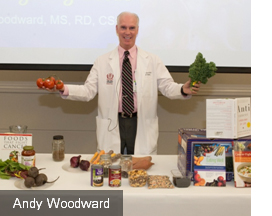
Cancer-fighting Foods Demonstration: 11:45 a.m. – 12:45 p.m.
One hundred attendeeds were able to sample vegetarian street tacos, beet salad, hibiscus tea, and berry parfait while listening to registered dietitian with Board Certification as a Specialist in Oncology Nutrition, Andy Woodward, share his thoughts on cooking and eating healthy to reduce cancer risk, heart disease, inflammation, and more.
Proton Documentary Screening: 1:00 – 1:30 p.m.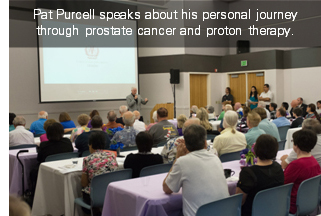
More than 100 gathered to hear former proton patient and BOB member Pat Purcell speak about his journey through prostate cancer and proton therapy. Pat also introduced a sensational documentary, titled “Against All Odds,” produced by the Loma Linda Advancement Films team, about his journey from diagnosis to treatment to completing an Ironman triathlon.
Proton History Wall Unveiling & Mixer: 3:00 – 4:30 p.m.
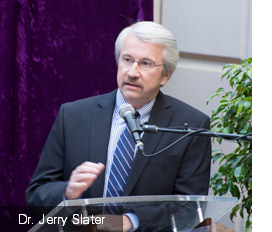
This event showcased the long and illustrious journey and accomplishments of LLUCC over the past 25 years. In addition to the actual development of proton technology for cancer treatment in the hospital setting, some of the many milestones featured on the wall include the center’s work with NASA to research the effects of radiation in space; the development of a robotic Precision Patient Alignment System, which further improves the accuracy of repeatable patient positioning; and countless clinical trials that continue to improve and expand proton treatment’s effectiveness.
During the ceremony, Dr. Jerry Slater reported, “The future of proton is incredibly promising thanks to technological advancements that will allow for the treatment of additional types of difficult-to-reach tumors while, at the same time, expanding proton’s effectiveness in the treatment of numerous other diseases and conditions.”
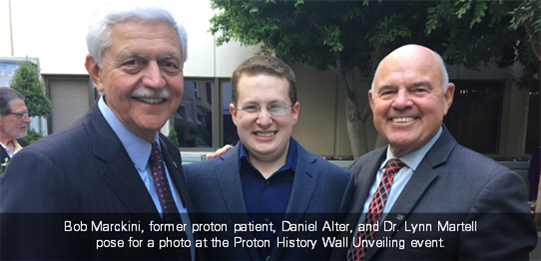
Proton Homecoming Event: 4:45 – 6:00 p.m.
Hundreds of former cancer patients and family members reunited at the LLU Drayson Center to celebrate their renewed health and the trailblazing proton radiation technology that helped them beat the disease.
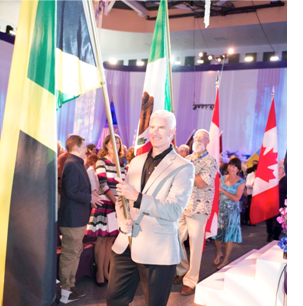 Flag Prelude
Flag Prelude
At the beginning of the celebration, a triumphant version of “The Battle Hymn of the Republic” was played as former patients and their family members paraded into the room holding flags. The flags symbolized the fact that more than 18,000 people from 49 nations have been treated with proton thereapy at LLUCC since 1990.
The flag prelude was followed by the Pledge of Allegiance, led by LLU Health president Dr. Richard Hart’s three grandchildren.
Celebrating 25 Years
Dr. Hart welcomed attendees to the event and opened with a prayer. He then introduced the evening’s Master of Ceremonies and “the one person we all know here in the room,” Dr. J. Lynn Martell, Director of Special Services at LLUCC James M. Slater, MD Proton Treatment & Research Center.
Dr. Martell took the microphone to introduce a comprehensive and inspirational video about the history of proton therapy at the James M. Slater, MD Proton Treatment & Research Center, “Celebrating 25 Years.”
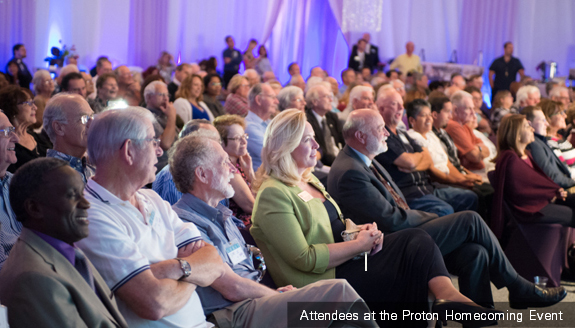
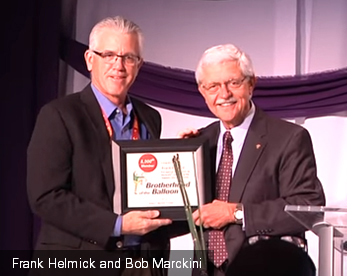 8,000th BOB Member
8,000th BOB Member
Bob Marckini gave a brief history of the Brotherhood of the Balloon, how six guys got together after treatment and vowed to stay in touch, explained how the organization was named, and then introduced the BOB’s 8,000th member, Frank Helmick. Frank accepted a plaque that read, “For special recognition as the 8,000th member of the majestic and prestigious Brotherhood of the Balloon.”
Bob then recognized his daughter, Deb Hickey, and the help she has provided him over the years. He identified specific BOB members who have gone above and beyond to support our organization including Bob Reimer and Dr. Terry Wepsic. Both Bob and Terry have spent a lot of time on the phone with newly diagnosed men, sharing their experiences and calming their fears.
A Surprise Roast
It was then time for Bob’s surprise—a roast of Dr. Lynn Martell. Bob began by comparing his and Lynn’s relationship to mismatched roommates, Felix Unger (Bob) and Oscar Madison (Lynn), of The Odd Couple. The theme of the roast was “Ready … Fire … Aim!” Bob poked fun at Lynn’s rather perfunctory planning style versus Bob’s own obsessive, compulsive and over-the-top approach … to just about anything.
To illustrate their differences, Bob told stories about the different approach each would take in learning how to swim and Lynn’s inviting 85 proton patients to his home for Christmas dinner 15 years ago, without first telling his wife, Karen. This left some guests to sit down to dinner in the bedrooms, hallways, and bathrooms. He also related stories of a “harmless hike up a hill” and travels with Lynn where they were left hotel-less and hungry at midnight. The audience roared with laughter.
BOB member, Steve Cohan, was the next to poke fun at Dr. Martell. He spoke about his first impressions of Lynn, told a few humorous stories, and ended with a sincere message of gratitude for the care and compassion demonstrated by Dr. Martell throughout the treatment process.
Bob Marckini then returned to praise Dr. Martell for being such an important part of so many people’s lives. He told the audience that it was Dr. Martell who encouraged Bob to press on with his “ministry,” the BOB, in the early years when it was growing out of control and he wasn’t sure he could handle it. He thanked Lynn for his personal support over the years, “Lynn, I will be eternally grateful to you and for what you have done for me and this movement.”
Bob then invited Dr. Richard Hart to the stage for a special presentation.
Honoring Dr. Martell
Dr. Hart gave special recognition to Dr. Lynn Martell for his tireless work with proton patients with the support of his wife, Karen, whom he referred to as “the anchor behind all this; the one who makes it all happen.” Dr. Hart then announced that LLUCC James M. Slater, MD Proton Treatment & Research Center will be renaming the patient education room the “J. Lynn Martell Patient Education Room.” The plaque, which will be placed outside the room, will read:
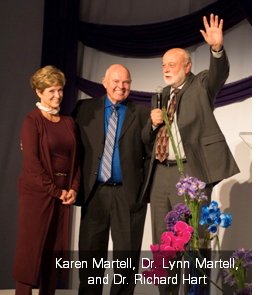 J. Lynn Martell, DMin, joined the leadership team of Loma Linda University Health in 1999. He volunteered at the James M. Slater, MD Proton Treatment and Research Center and was instrumental, with Bob Marckini, in growing the Brotherhood of the Balloon, a prostate cancer support group. In 2007, Dr. Martell transitioned to working with proton patients full-time. He is known for his passion for people and his deep commitment to the ministry of Loma Linda.
J. Lynn Martell, DMin, joined the leadership team of Loma Linda University Health in 1999. He volunteered at the James M. Slater, MD Proton Treatment and Research Center and was instrumental, with Bob Marckini, in growing the Brotherhood of the Balloon, a prostate cancer support group. In 2007, Dr. Martell transitioned to working with proton patients full-time. He is known for his passion for people and his deep commitment to the ministry of Loma Linda.
Special Messages of Thanks
A Thank You from Loma Linda University Health
We would like to extend a special thank you to the more than 150 people who contributed to capital improvements in the proton area and helped make this honor possible.
A Thank You from the Martells
Dear Friends,
Karen and I were thrilled to be a part of the 25th anniversary celebration of the proton center at Loma Linda. It has been a privilege, a joy, and a fulfilling aspect of our ministry. We want to express our deepest appreciation for all of you who made donations in our honor of the naming opportunity. We were in awe as we saw list after list of people who had donated — some remembering in their estate plan. Thanks so much for this great honor. Please continue to remember Loma Linda in your prayers and charitable giving. Karen and I invite you to join us in also remembering Loma Linda in your estate plan.
Happy holidays and keep looking up!
Looking to the Future
Dr. Martell introduced a video about the future of proton therapy at LLUCC. In the video, we learned that proton therapy will be used for more advanced-stage disease such as breast cancer that has spread to the lymph nodes, more pediatric cancers, pancreatic cancer, esophogeal cancer and other gastrointestinal cancers, tumors in the liver, and several non-cancerous disorders such as atrial fibrillation. As mentioned in our News Report, proton therapy is being investigated for the treatment of pain for injured military veterans.
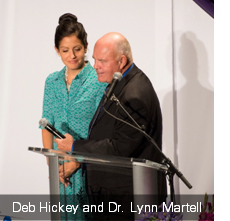 The Interviews
The Interviews
Dr. Martell then introduced and interviewed the BOB’s Deb Hickey, BOB member Scott Wilcox, breast cancer survivor Vicki Ramirez, and chordoma survivor Daniel Alter.
Deb spoke about her father, Bob Marckini’s prostate cancer diagnosis right before her wedding, and how she felt about it. She explained the research he did and his ultimate decision to go to LLUCC for proton treatment.
Deb also recognized BOB member, Scott Wilcox, for his dedication to the “ministry” and the many ways he goes out of his way to help newly diagnosed men learn about proton therapy through sharing his experience.
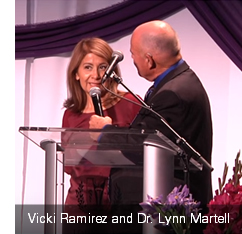 Vicki Ramirez actually worked at the Breast Health Center at LLUH when she was diagnosed with breast cancer. “By then, I knew what women with breast cancer went through … and now it was my turn,” she told the crowd. Initially, Vicki had surgery. She was then told she was a candidate for proton therapy. “For me, it was God’s hand,” she said through tears and went on to explain other devastating illnesses she had endured throughout her childhood and the care that she has received at LLUCC throughout her life. Ten years later, Vicki is cancer free.
Vicki Ramirez actually worked at the Breast Health Center at LLUH when she was diagnosed with breast cancer. “By then, I knew what women with breast cancer went through … and now it was my turn,” she told the crowd. Initially, Vicki had surgery. She was then told she was a candidate for proton therapy. “For me, it was God’s hand,” she said through tears and went on to explain other devastating illnesses she had endured throughout her childhood and the care that she has received at LLUCC throughout her life. Ten years later, Vicki is cancer free.
Scott Wilcox talked about his history of severe adverse reactions to surgical procedures and medications. He shared that he’d had several heart problems since his retirement in 2010. And, shortly after undergoing two cardiac ablations and several rounds of Coumadin for atrial fibrillation, his general practitioner told him his PSA was 8.6 and he’d better see a urologist.
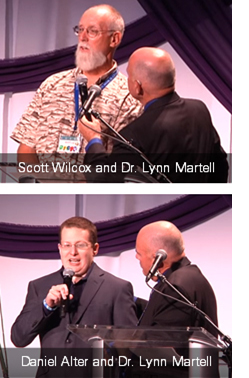 Scott spoke about the Divine way he learned about proton therapy and LLUCC. He referred to his prostate cancer diagnosis and proton treatment at LLUCC as “probably one of the best experiences of my life.” He thanked LLUCC for saving and preserving the quality of his life. He stated that he and Anne had pledged a signifiant portion of their estate to continuing proton research and encouraged audience members to do the same.
Scott spoke about the Divine way he learned about proton therapy and LLUCC. He referred to his prostate cancer diagnosis and proton treatment at LLUCC as “probably one of the best experiences of my life.” He thanked LLUCC for saving and preserving the quality of his life. He stated that he and Anne had pledged a signifiant portion of their estate to continuing proton research and encouraged audience members to do the same.
Daniel Alter spoke about his “very rare brain tumor” diagnosis (chordoma) as a child in 1997. He underwent surgery followed by proton therapy at LLUCC. Years later, he earned bachelors degrees in archaeology and anthropology, and masters degrees in Jewish Education and Hebrew Letters. Eighteen years after his proton treatment, Daniel will soon be an ordained rabbi.
You’ll Never Walk Alone
Dr. Martell asked all current and former proton patients in the audience to come to the stage. Singer, composer, and recording artist, Desmond Clark, then sang a beautiful rendition of “You’ll Never Walk Alone.” Most in the room were brought to tears. It was an amazing and graphic reminder that these hundreds of people conquered cancer thanks to Dr. James Slater’s remarkable dream of proton radiation.
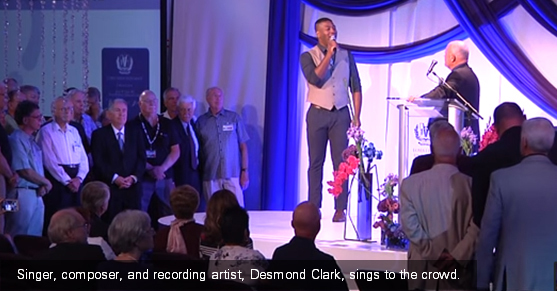
More photos from the 25th anniversary celebration will soon be available on the ProtonBob.com website.
Watch the entire 25th Anniversary Homecoming Event.
Recap: ASTRO 2015 Annual Meeting

– Contributed by Todd Ketch, Executive Director of NAPT
The ASTRO Annual Meeting at a Glance
The American Society of Therapeutic Radiation Oncology (ASTRO) meets annually so that radiation oncologists and medical physicists can share best practices, recent research, and ideas for future advances in radiation therapy.
This year’s ASTRO meeting represented progress in multiple areas. At the same time that Loma Linda University Cancer Center was celebrating 25 years of successfully treating cancer patients with proton therapy, several of the elected clinical leaders and radiation oncologists of ASTRO have treated their own patients with proton therapy.
It’s also important that ASTRO’s current model insurance coverage policy, which is what ASTRO recommends Medicare and commercial insurance companies use when deciding which medical therapies should be paid for, offers some support for proton therapy for treating a range of cancers.
Largely absent from this year’s meeting was any significant lingering undercurrent about the cost and efficacy of proton therapy. It is hard to argue with consistently successful outcomes.
The Focus of this Year’s Meeting
The focus of this year’s ASTRO meeting was the presentation of new clinical research. It is no surprise that there is more research than ever on proton therapy demonstrating improved survival and fewer side effects. The increased research is due to more proton therapy centers (18 are now treating patients), insurers, and government health policy agencies demanding “evidence based medicine.” The evidence is clear. Not only is proton therapy as good as, and often better than, other types of radiation therapy, the side effects are almost always fewer and less severe. From a patient’s perspective, these results are no surprise since proton therapy gives the same or higher dose to the cancer and a much lower dose to surrounding healthy tissue.
Research Results
Research results presented at ASTRO 2015 for the most common cancers, including prostate cancer, breast cancer, and non-small cell lung cancer consistently showed that proton therapy provides patients with meaningful clinical benefits.
The Oncology Nurse Advisor’s report on ASTRO 2015 stated: “New data from clinical trials conducted demonstrate the technology's potential advantages over conventional radiation, including fewer side effects and survival in some cases, for several harder-to-treat tumors: pancreatic cancer, late-stage non-small cell lung cancer, and chordoma and chondrosarcoma.”
Prostate Cancer
Three abstracts and nine posters at the conference focused on prostate cancer. The abstracts reported on hypofractionation—giving daily treatments at higher doses thereby shortening overall treatment time. The nine posters on prostate cancer focused mostly on long-term outcomes and advanced prostate cancer. The emergence of hypofractionation, which is generally 20 fractions (treatments), augers well for the future, since fewer treatments are not only more convenient for patients but also reduce the cost of treatment by almost 50 percent. The studies presented for hypofractionation show there is equivalent tumor control and disease-free survival with minimal side effects comparable to the standard proton therapy treatment protocol.
Breast Cancer
Reports on breast cancer research showed that proton therapy reduces cardiac morbidity and mortality when compared to conventional radiation. This is a significant benefit, especially when treating left-breast tumors.
Lung Cancer
The most common form of lung cancer is stage III non-small cell. Most patients with this disease have impaired pulmonary function and cannot tolerate conventional radiation therapy. These patients generally tolerate proton therapy well, and they experience a significant survival advantage.
The Challenge of Proton Therapy Clinical Trials
Just as important as the actual studies is the growing realization that prospective randomized clinical trials, which are typically done for drugs, are neither necessary nor ethical for comparing proton therapy to other forms of radiation therapy. In a prospective randomized trial comparing proton therapy to photon therapy (IMRT), two patients would be told their tumors would both receive the same amount of radiation but that one of them would receive a much larger dose of radiation to their healthy tissue. When patients are presented with this reality, they typically reject any consideration of participating in such a study.
In Summary
We at NAPT believe that as proton therapy becomes an accepted therapy for more than “just” prostate cancer, it will make it harder for insurance companies to discourage prostate cancer patients and other cancer patients from receiving proton therapy and easier for leading cancer centers to add proton therapy to their oncology programs.
Despite the research confirming what we know from our own experience to be true, proton therapy is still not widely recognized as a viable treatment option and is available to fewer than 1 percent of the cancer patients who receive radiation therapy.
Recap: BOB Reunion, Redding, CA
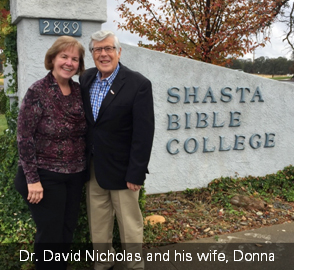 A BOB reunion was held in Redding, CA, last month. The event was hosted by BOB member Dr. David Nicholas, President of Shasta Bible College, and his wife, Donna.
A BOB reunion was held in Redding, CA, last month. The event was hosted by BOB member Dr. David Nicholas, President of Shasta Bible College, and his wife, Donna.
Nearly 70 former proton patients and their family members were in attendance. Dr. Nicholas’ staff prepared a beautiful table of refreshments for guests. He also expertly played the trombone while some of his students provided additional music.
Afterward, Dr. Lynn Martell gave an update on LLUCC’s 25th anniversary celebration and Vision 2020. He also shared information on current proton therapy clinical trials at LLUCC. Lynn’s wife, Karen, and Matt Miller, Senior Development Director of Philanthropy at LLUCC were also there to help with the program. Two videos were presented—“The History of Proton Therapy” and “The Future of Proton Therapy.” The group unanimously expressed a desire to meet again next year.
After the event, Lynn received the following message from one of the attendees:
Many fond memories were stirred by the reunion and I was impressed with all the advancements LLUCC has made since my treatment in 2009 … When you spoke of the shortened 20-treatment fast track through the proton therapy program, I immediately felt,“What?! Shorten my radiation vacation?!” When my treatment ended, I left Loma Linda with a significant sense of loss revealing how deeply I embraced the community and enjoyed my stay. I did not spend the last two weeks of treatment counting down the days until I could get back home. This is a deep testimony to the quality of the program at Loma Linda and the holistic approach to healing where community matters.
Upcoming: National Proton Conference 2016
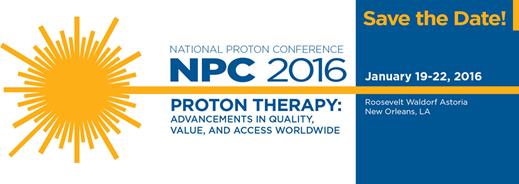
The National Association for Proton Therapy (NAPT) will be holding its National Proton Conference on January 19-22, 2016, at the Roosevelt Hotel, New Orleans, Louisiana. Registration is open.
Special Acknowledgment
As mentioned in the opening memo, NAPT informed us last month that Bob Marckini would be receiving a special award at NPC2016 on January 21. Here is what they said:
Next to Dr James M. Slater, Bob Marckini has done more to increase patient access to proton therapy than anyone else. The National Association of Proton Therapy is recognizing Bob Marckini with their Lifetime Achievement Award at the NPC2016 Conference. As the founder of the Brotherhood of the Balloon, the only patient advocacy group that can claim over 70 percent of all patients treated with a particular modality as members, Bob has provided thousands of prostate cancer patients with objective information that enables them to make informed choices about their care.
NAPT is offering a discount for any BOB members who wish to attend the conference. They have established a special one-day rate of $250 for January 21 and $550 for the entire three-day conference. Enter the discount code “BOB” to get the discount when registering at www.npc2016.com.
More Conference Information
Exhibits: There are typically large halls filled with exhibits showing the latest developments in proton therapy technology, equipment, systems, and support systems. Information is presented on new particle accelerator design, new beam delivery systems, more precise control systems, and many things connected with proton therapy, including, the latest and greatest rectal balloon designs (!).
Attendance: Proton centers from all over the world send representatives to the annual conference. Often clinicians and clinical leaders from all the major U.S. proton centers are in attendance, many participate in panel discussions.
Panels and Presentations: Several presenters and panels will address a variety of proton related issues ranging from the latest developments in proton therapy research, clinical and technological advances in proton therapy, NAPT survey results, global proton initiatives, and the economics and sustainability of proton center development and growth.
Medical Insurance: This subject is always on the agenda with presentations and panel discussions about the latest developments, a subject of great interest to us prostate cancer survivors.
Meals and Social: Continental breakfasts and lunches are provided, and there are evening receptions where participants can mingle and learn.
Register now. Questions regarding the event can be sent to Lis Veilleux at NAPT.

Member Feedback: “It’s Been 15 Years”
Last month, following Deb Hickey’s introductory memo to members, we received hundreds of heartfelt responses. We share just a few excerpts with you below:
Dennis Hall, Spokane, WA
 I was very moved by your letter about your dad and wedding, especially your father/daughter dance song. Our daughter got married last month and that was our song as well … I forwarded the newsletter to my wife, Debby, and daughter. It took my wife three tissues to get through it. And, I thought I would let you see my daughter’s response:
I was very moved by your letter about your dad and wedding, especially your father/daughter dance song. Our daughter got married last month and that was our song as well … I forwarded the newsletter to my wife, Debby, and daughter. It took my wife three tissues to get through it. And, I thought I would let you see my daughter’s response:
“Dad, I love it. I, too, had those thoughts of you walking me down the aisle at my wedding when Mom told me your test results pointed to cancer. Our father-daughter dance will always be special to me and I can’t wait for the final part—having children that get to call you Papa! I love you, Daddy. Thank you for sharing this with me.”
Charlie Mack, Las Vegas, NV
Your intro to this month’s BOB Tales literally made my eyes tear up. Maybe it’s because today is our daughter’s 29th birthday. Maybe it’s because my family felt the exact same way you did when I was diagnosed. Maybe it’s because, like your dad, I had no doubt what my treatment course would be. Maybe it’s because your tribute comes from a very deep place inside you. Or maybe it’s all of the above (and probably more).
Richard Mesh, Phoenix, AZ
I want to send you a thank you on behalf of all the fathers in the world who have had prostate cancer and have a daughter. Your tribute to your dad was one that I think all fathers in the world would love to see from their own daughters. I dare say you captured in mere words that special emotional bond that all of us guys hope to someday experience with our offspring. How could it not bring a tear to a grown man’s eye? So, thank you for putting it so eloquently.
The Rev Dr. Federico I. Agnir, Wesley Chapel, FL
I sobbed like a little kid while reading your note in the November newsletter. I wish my own children could write as well about how they felt 13 years ago when I shared with them the dreaded C word.
Ron Yedloutschnig, Southold, NY
Wow, Deb! Your note “It’s been 15 years” brought tears to the eyes of this 85 year-old man. I am lucky also as I am sure my two sons feel the same about me. And, my wife, Jean, has stuck by me for 59 years on the 26th of this month! Your dad, I am certain, is as proud of his daughter as you are of him!
Anonymous Reader
I’m not reading any more “Note from Deb Hickey.” My heart can’t take it.
 Birthday Milestone
Birthday Milestone
Jacques “Frenchy” Houot was treated with proton therapy for his prostate cancer in 2003 at the age of 67. We have written about Frenchy several times in our newsletter, our Facebook profile, and he has a story on our Life after Proton Web page. An avid bicyclist and Alpine ski racer, he continued to follow his passion after treatment, winning race after race in both sports in his age category … where he was usually the oldest.
Frenchy turned 80 last month and guess how he celebrated his birthday? He completed a bicycle race—the “Aloha Shaka Cross Series”—in Carbondale, CO. This isn’t just any bike race.
“Cyclocross,” is a mixture of grass, pavement, and dirt, featuring obstacles and dismounts that require shouldering the bike on a closed course of 1-2 miles. Men half Frenchy’s age couldn’t tackle this type of race … It must be the protons.
Frenchy’s goal was always to keep racing until he reached 80. It looks like he’s accomplished that! “I always finish what I start—no problem,” Jacques said.
The day after the race, his friends threw Frenchy a “big bash.” They served food and beverages, and enjoyed “a huge petanque tournament” in the backyard. Happy birthday, Frenchy!
More Member Feedback
BOB member, Tom Halsted, read an article in last month’s BOB Tales where we featured Mrs. Marisabel Nicoletti who was treated with proton therapy for a brain tumor. Tom said,
When I was diagnosed with prostate cancer in 2007, I told my urologist that I wasn’t going to have surgery, brachytherapy, or IMRT. I told him I had decided to go to Loma Linda for proton radiation. He said, “Great!”
Coming from a man whose main job is surgery, his response was surprising. But then he went on to tell me his wife had had what her doctor had told her was an inoperable brain tumor. They did the research; she went to MGH for proton treatment; and the tumor is gone. So, he is a strong believer in protons.

Please Consider the Marckini Chair in Your Year-end Giving
Most of our members contribute generously to charitable institutions over the course of the year. Year end is often a time when people give the most. It’s the end of the tax year and it’s also holiday time, a time for reflection and giving thanks. We are happy to report that almost 40 percent of our members participate in giving back to support proton therapy research though endowed chairs at Loma Linda University Health.
We all have our favorite charities. And so many of are worthy of our consideration. We at the BOB hope that as you plan your year-end giving, you give some thought to supporting the endowed chair named in honor of Bob Marckini.
What is an Endowed Chair?
An endowed chair is a distinction awarded by an institution, usually to an individual, in recognition of past and potential contributions to the institution‘s mission. In addition to the academic honor given to the individual, an endowed chair provides funding for specific programs, and is supported by payout from interest earned on the principle collected. So, the money raised for an endowed chair is always protected. The interest earned from the endowment is used to fund research. This interest is typically around 4 percent.
The Marckini Chair is Funding Research
Thus far this year, members’gifts have added $60,902 to the Robert J. Marckini Chair. Thanks to your generosity, the Marckini Chair total is up to $2,101,727 and is funding important proton research at Loma Linda University Cancer Center.
Our goal for the chair is $5 million and we are well on our way toward that target. Members also added $38,150 to the Dr. James M. Slater Chair, which is funded at more than $5 million and also supporting critically important proton therapy research, some of which is described in this newsletter.
Please Consider Our Chair in Your Year-end Giving
If you are thankful for the proton therapy you received, whether at Loma Linda or one of the other proton treatment centers, why not consider making a gift to the institution that played such a critical role in pioneering the technology? Or, if you feel we, the Brotherhood of the Balloon, have helped you in any way—though our email and phone communications, our newsletters, our website, Facebook, blog, PowerPoint presentation, medical insurance support, or other services we provide—and you are looking for a way to acknowledge this, please consider making a gift to the Marckini Chair or the Dr. James M. Slater Chair. Both support important proton therapy research.
Some of our members have asked to donate to the BOB directly. We are very thankful for the thought, but we ask that any donations go to further proton research for others. Remember, your gift is tax deductible. And, you’ll see below that the process is simple.
Honor a Friend, Caregiver, or Proton Center
When you make your gift, you can do so in the name of someone you would like to honor, such as a caregiver at the institution or someone outside the institution, like a friend or member of your family. A letter will be sent to that individual informing him/her that a gift was made in his or her honor.
We sincerely thank you for anything you can do to support proton therapy research though these endowed chairs.
Member Featured in Cincinnati Newspaper
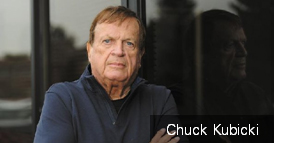
BOB member and major supporter of our organization, Chuck Kubicki, was recently interviewed by the Cincinnati Business Courier. In the article titled “Kubicki’s code: Practicing ‘lost art’ of hard work is only way to win,” Chuck talks about the huge growth and success of his real estate development company. He discusses how he motivates his employees and shares career advice. He also gets personal by discussing his at-home habits and morning routine, his biggest pet peeves, and what he was like as a kid.
One of the last questions asked of Chuck was: “You have $100,000 to donate to charity. Which one and why?”
Chuck’s answered, “Loma Linda University Cancer Center. They were the pioneers of proton beam therapy for the treatment of cancer and continue to be on the cutting edge of research and treatment. They run their operations in a first-class manner and truly have a passion for improving the health and wellness of anyone who seeks their expertise.”

BOB Comment: Chuck, your generosity over the years has been extraordinary. You are a big part of why LLUCC has been able to move Vision 2020 forward and make so many important advancements in proton therapy. You are the one who initiated, through a large donation, the “Brotherhood of the Balloon Fund” for proton research which eventually became the Robert J. Marckini Endowed Chair. You continue to invigorate us by finding ways to give back for the gift of proton treatment you received some 13 years ago. Thank you for your continued support of our efforts. You are an inspiration to all of us.

How to Support Proton Research
Make a Future Gift:
Contact Todd Mekelburg at the Office of Planned Giving at Loma Linda University Health at 909-558-4553 or email [email protected].
Donate to the Marckini Chair:
- Send a check made out to “LLUCC Proton” to Loma Linda University Health, Office of Philanthropy, P.O. Box 2000, Loma Linda, CA 92354. Memo line: “Marckini Chair.”
- Donate online or call Elvia DeHaro at 909-558-5010.
Other Ways to Give:
Contact Matt Miller at the Office of Philanthropy at Loma Linda University Health at 909-558-3284 or email [email protected].

Prevent Heart Disease: Get a Dog
 According to the American Heart Association, having a dog may protect you from heart disease. Dogs give people more reasons to take walks, and most owners bond so closely with their dogs that their reactions to stress are muted and their heart rates slower.
According to the American Heart Association, having a dog may protect you from heart disease. Dogs give people more reasons to take walks, and most owners bond so closely with their dogs that their reactions to stress are muted and their heart rates slower.
The Centers for Disease Control and Prevention (CDC) and the National Institute of Health (NIH) have also conducted heart-related studies on people who have pets. The findings showed that pet owners exhibit decreased blood pressure, cholesterol, and triglyceride levels—all of which can ultimately minimize their risk for having a heart attack down the road.
For those who have already experienced a heart attack, research also indicates that patients with a dog or a cat tend to have better recovery rates. These benefits are thought to be connected with pets’ tendency to help reduce or at least control their owners’ overall stress levels.
Why Your Heart Loves the Flu Shot
Are you still contemplating a flu shot this year? Well, if the sore throat, high fever, runny nose, and chills aren’t enough to convince you, this might: Getting a flu shot may help protect your heart according to a recent study.
In the study, which involved 7,000 people, it was determined that those who got the flu shot were 36% less likely to have a heart attack or heart-related hospitalization, compared to those who didn’t get the vaccine. And the risk was 55% lower with participants who had a history of heart disease. And, the risk of dying from heart disease was reduced by 20%.
Researchers believe that inflammation which occurs when your body fights the flu can cause plaque in the arteries to erupt, leading to a heart attack or another event. By preventing the flu, the vaccine protects you from that harmful inflammation.
The 7 Germiest Spots in your Home
From Bottom Line Personal, Vol 36, No 20, 10/15/15, Charles Peter Gerba, PhD, University of Arizona
People are often germaphobes in public, but they tend to relax in their own homes. Yet germs are lurking in your home and they can spread amazingly fast. Disease-causing germs, called pathogens, include cold and flu viruses and food-borne bacteria such as E.coli and Salmonella that can cause dangerous intestinal tract infections. About 20 percent of food poisoning outbreaks are related to food handling in the home, according to the Centers for Disease Control (CDC). Here are where germs are most likely to hide in your home, and some things you can do about it:
| Kitchen Sponge: It’s the dirtiest thing in the house. Fifteen percent test positive for Salmonella and they are often contaminated with E. coli as well. | Solution: Disinfect your sponge by zapping it in the microwave for 30 seconds, running it through the dishwasher, or soaking it in a bleach-water solution once a week. | |
| Cutting Boards: The average cutting board has 200 times more fecal bacteria than toilets. According to Dr. Gerba, you’re safer making a sandwich on a typical toilet seat than on a typical cutting board! | Solution: Wipe wooden boards generously with a sponge soaked in a solution of two tablespoons of bleach to one gallon of water. Run plastic cutting boards through the dishwasher. | |
| Kitchen Towels: People frequently touch their kitchen towels when preparing meals using raw chicken or ground beef. And, they often wipe their hands on these contaminated towels after they wash their hands. | Solution: Use paper towels after handling raw chicken and beef, or wash your hands with soap and water before handling kitchen towels. | |
| Bars of Soap: Germs can easily live in the “slime” around a bar of soap, even antibacterial soap. This can be risky for people with compromised immune systems. | Solution: Use alcohol-based hand sanitizers unless your hands are very dirty—then wash them first. Infection risk is reduced 70 to 80 percent with hand sanitizers. Liquid hand soap is also an option. | |
| Bathroom Towels: The CDC recommends thoroughly lathering all hand surfaces for 20 seconds when washing, then rinsing and drying. Also, flushing the toilet with an open lid can spread bacteria up to six feet, including towels close by. | Solution: Wash bathroom towels every two or three days. Close the toilet lid before flushing. Thoroughly wash your hands and/or use hand sanitizer after every trip to the bathroom. | |
| Phones, Remotes, Computer Keyboards: Germs can survive longer on inanimate objects than on your skin, which has anti-microbial properties. We are constantly contaminating phones, remotes, and keyboards because we all use them so much. If your phone rings while cutting raw meat, you are likely to transfer germs to the phone. | Solution: At least once a week, wipe down these devices with an alcohol sanitizer. Do it daily during the flu season. Always wipe down the phone if you used it while handling raw meat. | |
| Laundry: It’s dirtier than you think. When you load clothes into the washer, especially underwear, you could be picking up huge numbers of pathogens. And, there is no guarantee clothing will be germ-free after the wash cycle, because most households use cold-water settings, which do not kill all germs. | Solution: Wash clothes in hot water. After washing severely contaminated clothing, run the washer empty using two cups of bleach to kill remaining germs. |
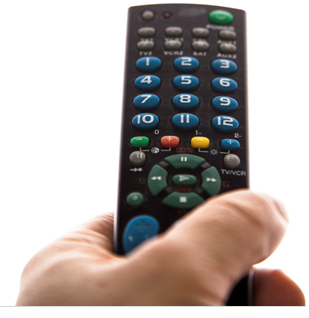 Series: Top 20 Most Common Health Questions
Series: Top 20 Most Common Health Questions
Last year, we began a series on the top 20 most common health questions (and answers) from Business Insider Magazine. Here is another question from that list.
Can watching TV ruin your eyesight?
Short answer: No. Watching TV will not destroy your rods and cones as the outdated myth suggests. Before the 1950s, TVs emitted radiation that could increase an individual's risk of eye problems after excessive TV viewing. Modern TVs have special shielding that blocks these harmful emissions.

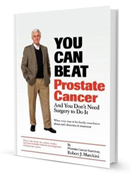
The Process is Easy: Please Help Us Reach More Newly Diagnosed Men
When you read the email below from a new proton therapy patient, you’ll understand why it’s so important to keep Bob’s book, “You Can Beat Prostate Cancer: And You Don’t Need Surgery To Do It,” at the top of the search listings for keyword phrase, “prostate cancer,” on Amazon.
Book positioning in the search results is based on a combination of sales (both hard copy and Kindle versions) and weighed heavily upon reader reviews. We have the largest number of reader reviews (238) of any book in the top 50 on Amazon. But one book is catching up to ours, “Guide to Surviving Prostate Cancer,” by Dr. Patrick Walsh. This book, which promotes surgery, is in the number one position and has 210 reviews.
If Bob’s book helped you in any way, please help us maintain or improve its position in Amazon. Go to Amazon, write a short review, and rate the book from 1 to 5 stars. Just click here and click on the "Write a review" button. Help others find out about proton therapy for prostate cancer!
Below is an excerpt from an email sent to Bob Marckini from a new proton patient who is being treated at LLUCC. It is a great example of why it’s so important that Bob’s book remain in the top search results among other books about prostate cancer treatment options on Amazon.
Dr. Lynn Martell asked me how I discovered proton therapy (and my wife had asked me the same thing). I have Amazon to thank. When I was diagnosed with prostate cancer in May, my urologist recommended that I obtain Dr. McGovern’s book about “nerve- sparing” surgery. When I was on the Amazon website, Amazon’s intelligent algorithm also recommended your book, which I ordered. I had never heard of proton therapy before—so you could say, Bob, that both you and Amazon changed my life.
Spanish Translation Available Complete
Thanks to the generosity of one of our members, our book has been translated into Spanish and will soon be available to the Latin community around the world.
Holiday Discount for BOB Members
Time is running out! Get a holiday discount on an order of five books or more. Don’t have a friend or relative who may benefit from learning about proton therapy for prostate cancer? Celebrate the holiday with the gift of giving—donate a book to your local library; give one to your family doctor’s office; drop one off at a neighbor’s doorstep; leave one at your dentist’s office; hand a few out at church … There are many opportunities to make a difference this holiday season.
The discount ends December 31, 2015. Shipping adds a few dollars more.

Email [email protected] with your order. Proceeds from book sales support proton therapy research through the Robert J. Marckini Endowed Chair at LLUCC.
Buy Online
Paperback: $19.00--•--Kindle: $9.99--•--NOOK Book: $9.99--•--Apple iBook: $9.99

IRS Warns of Phone Scam
Many people have reported they received phone calls or emails from people claiming to be from the IRS and being told they owe money and must pay now.
The IRS says it will always send taxpayers a written notification of any tax due via the U.S. mail and never asks for credit card, debit card, or prepaid card information over the telephone or by email. For more information to report a scam, go to www.irs.gov and type “scam” into the search box.
You can also contact the Federal Trade Commission and use their “FTC Complaint Assistant” at FTC.gov. Add “IRS Telephone Scam” to the comments of your complaint.
Thoroughly Useless Facts
- The average human sheds 40 pounds of skin in a lifetime.
- Because of a reflex action, a rattlesnake can bite you up to an hour after it’s dead.
- If you have at least 5/8 of a torn dollar bill, it can be redeemed for full value.
- The U.S. Government will not allow portraits of living persons on postage stamps.
Incredible Facts about the Human Body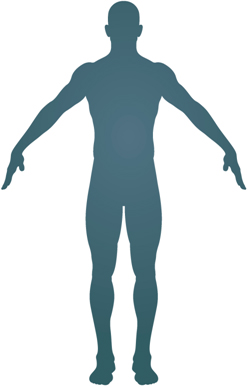
This is part of a four-part series on incredible facts about the human body. The human body is, without a doubt, the most incredible and complex “machine” on the face of the planet. In an age where
mankind sends people into space and keeps coming up with
greater inventions, the human body is still full of undiscovered mysteries. In this series, we will share some of them with you:
Part II of IV
- The surface area of a human lung is equal to that of a tennis court.
- Without mucus, your stomach would digest itself.
- Human thigh bones are four times stronger than concrete.
- Your nose and ears will continue to grow throughout your life. This is why older people tend to have large noses and ears.
Quote of the Month
“My grandfather once told me that there were two kinds of people: Those who do the work and those who take the credit. He told me to try to be in the first group; there was much less competition.” —Indira Gandhi

Last Month’s Brain Teaser
Two girls were born to the same mother, on the same day, at the same time, in the same month and year and yet they’re not twins.
How can this be?
Answer: The two babies are two of a set of triplets.
Winner: The first to write in with the correct answer to last month’s brain teaser was Don Coban of Rapid City, SD. Don is a former Air Force pilot. “I spent 39 years in the Air Force as a navigator which allowed me to see most of the world,” Don told us. “During that time I flew 32 models of aircraft.”
In the spring of 2002, Don and his wife, Virginia (Jinny), purchased a motorcoach and decided to “start traveling on the ground.” A few months later, Don was diagnosed with prostate cancer. Don’s first reaction? “Panic!!!”
Doctors suggested surgery, seeds, and watchful waiting, among other options, which left Don and Jinny confused and fearful. A phone call with a friend later calmed their fears. “I was on the phone with a friend we’d met during one of our RV excursions,” Don told us. “When I told her about my diagnosis, she told me a friend of hers would call me right back and hung up.” Moments later, Don received a call from a man who had been treated at Loma Linda University Cancer Center with proton therapy and was doing very well.
“The next day I called LLUCC,” Don said. Shortly thereafter, he received their orientation package. “That kit convinced me that proton was the way to go,” Don told us, “I have a technical background and everything just made sense.”
The day after Christmas in 2002, Don and Jinny headed to California in their coach.
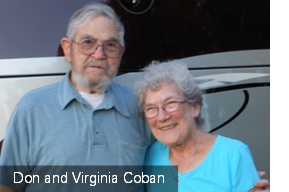 “The only way to describe my proton treatment is to say it was like a vacation —up early in the morning for the treatment and then off and running—to the beach, to the mountains, to wherever … and then it was time to leave,” Don told us. “We went back the next spring for my check-up and it was great. Thirteen years later, my PSA is less than 0.1.”
“The only way to describe my proton treatment is to say it was like a vacation —up early in the morning for the treatment and then off and running—to the beach, to the mountains, to wherever … and then it was time to leave,” Don told us. “We went back the next spring for my check-up and it was great. Thirteen years later, my PSA is less than 0.1.”
Don told us he encounters many people throughout his life suffering with ailments, many with cancer. “I have introduced quite a few men and women to the proton program—men for prostate and kidney cancer, and women for breast cancer.” Don added, “One thing I think is very important is to include the spouse in any discussion.”
Congratulations, Don! A signed copy of Bob’s book is on the way.

BOB Comment: Thank you, Don, for using your own experience to educate others about proton therapy for prostate cancer as well as other diseases.
We also think that including the significant other/partner in the treatment decision-making process is important. That is why we have put together a “Caregiver/Partner Reference List” of our members’ significant others for prospective patient family members and friends to contact for support and guidance throughout the treatment decision-making process. And, thank you, Jinny Coban, for volunteering to be on this reference list!
If you are the significant other of one of our members and wish to speak with wives/partners of newly diagnosed men to offer your support and guidance, please
let us know!

New Brain Teaser
Which stars do the following letters stand for?
AAAACCCDFGHIIIIIKLMMMMMMMM
NNNNNNNNOOOPRSSTTUVVWWWW
Answer next month: Send your brain teaser answers to [email protected].
Brain Teaser Feedback
We ask for it every month and appreciate any and all reader feedback on our newsletter. Last month, one of our members told us that he’s been trying for years to answer the brain teaser first, but he’s often away from his computer and doesn’t get to the newsletter for days, sometimes weeks, after it is issued.

Thank you for the suggestion—we will try it this month!
Looking at the Bright Side
A group of seniors was sitting around talking about all their ailments at Timmy’s Diner.
“My arms have got so weak I can hardly lift this cup of coffee,"” said one. “Yes, I know,” said another. “My cataracts are so bad; I can’t even see my coffee.”
“I couldn’t even mark an “X” at election time because my hands are so crippled,” volunteered a third. “What? Speak up! I can’t hear you,” said one lady.
“I can’t turn my head because of the arthritis in my neck,” said a man, to which several nodded weakly in agreement.
“My blood pressure pills make me dizzy!” exclaimed another. “I forget where I am and where I’m going,” said another.
“I guess that’s the price we pay for getting old,” winced an old man as he slowly shook his head. The others nodded in agreement.
“Well, count your blessings,” said a woman cheerfully … “Thank God we can all still drive.”
New Hearing Aid
A man was telling his neighbor, “I just bought a new hearing aid. It cost me five thousand dollars, but it’s state of the art—it’s the best you can buy.”
“Really,” answered the neighbor. “What kind is it?”
“Twelve thirty.”
The Pastor and Little Alex
One Sunday morning, a pastor noticed little Alex standing in the foyer of the church staring up at a large plaque. It was covered with names and small American flags mounted on either side of it. The 6-year-old had been staring at the plaque for some time, so the pastor walked up, stood beside the little boy, and said quietly, “Good morning, Alex.”
Alex replied, “Good morning, pastor.” Still focused on the plaque, the boy then asked, “Pastor, what is this?”
The pastor answered, “Well, son, it’s a memorial to all the young men and women who died in the (service).”
Soberly, they just stood together, staring at the large plaque. Finally, little Alex’s voice, barely audible and trembling with fear, asked, “Which service—the 8:15 or the 10:45?”

“There comes a time in your life, when you walk away from all
the drama and people who create it. You surround yourself with people who make you laugh.”
“Forget the bad, and focus on the good. Love the people who treat you right and pray for the ones who don’t.”
“Life is too short to be anything but happy. Falling down is a part of life; getting back up is living.”
—Jose Harris
We would like to wish you all a Happy Thanksgiving, a Merry Christmas, a Happy Hanukkah, and a holiday season filled with peace, joy, and good health. We hope the coming year will be overflowing with all the good things in life.
And, of course … Low PSAs to all!
Bob Marckini and Deb Hickey
Special note: We have members living in 39 countries around the world. In light of the recent terror attacks in San Bernardino, CA, Paris, and beyond, we offer our thoughts and prayers to any of our members, their families, friends, and anyone else who may have been affected by these terrible events. These are attacks against us all and we face these threats together. Good is always stronger than evil, and with God’s help, good will persevere.
To print the BOB Tales newsletter or view the newsletter with a larger font size, click here for the PDF file.
NO MEDICAL ADVICE: Material appearing here represents opinions offered by non-medically-trained laypersons. Comments shown here should NEVER be interpreted as specific medical advice and must be used only as background information when consulting with a qualified medical professional.
